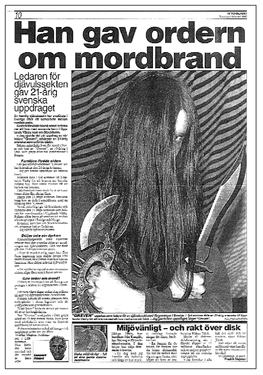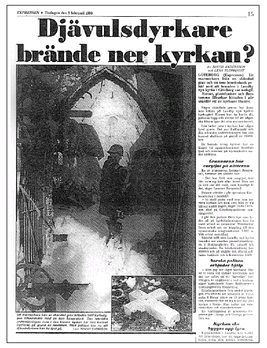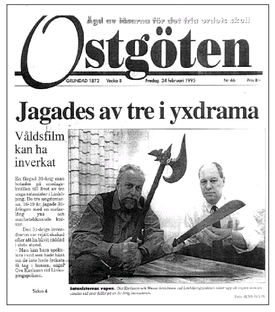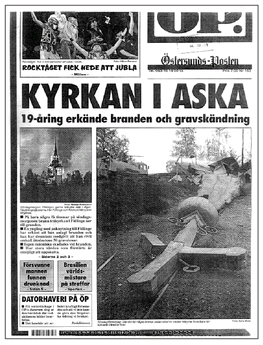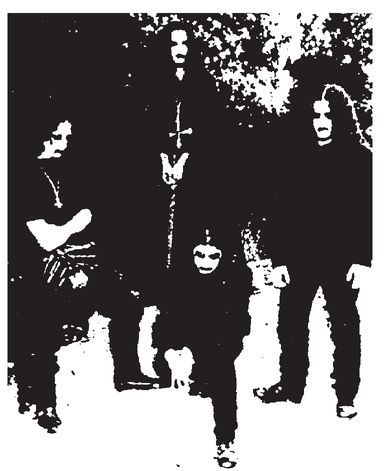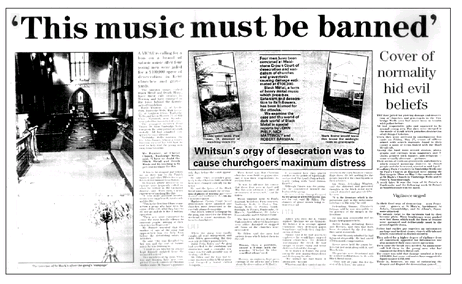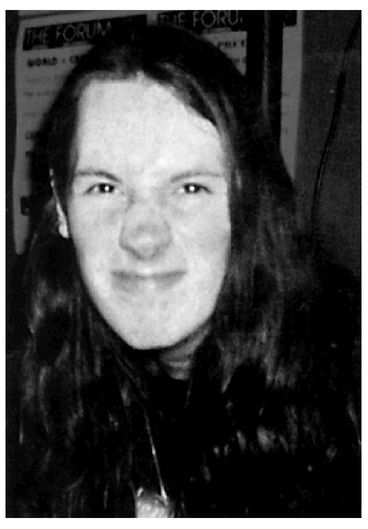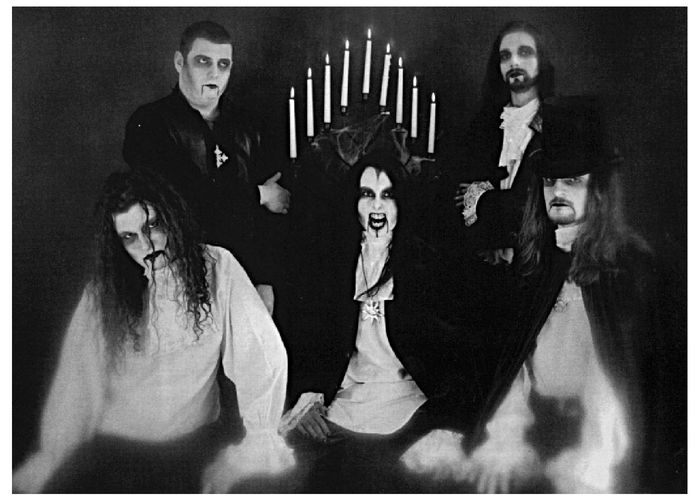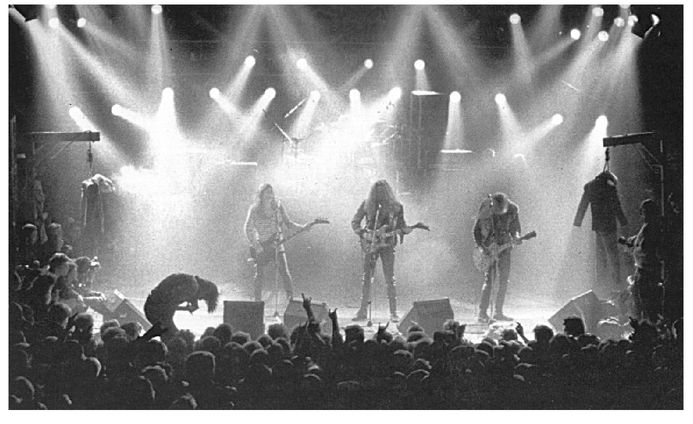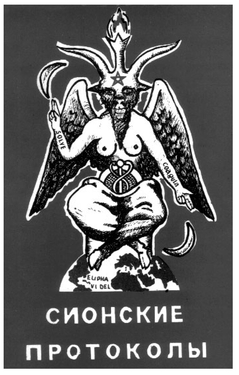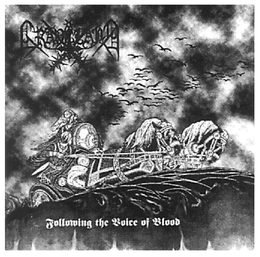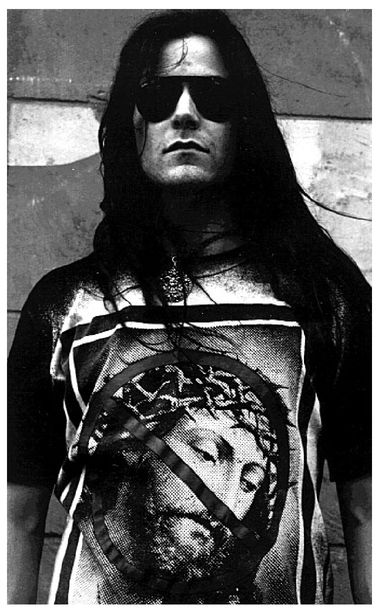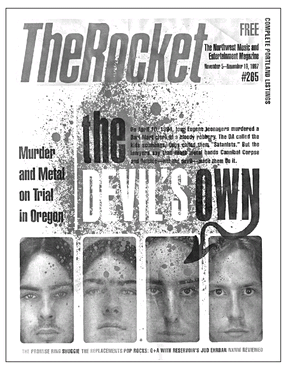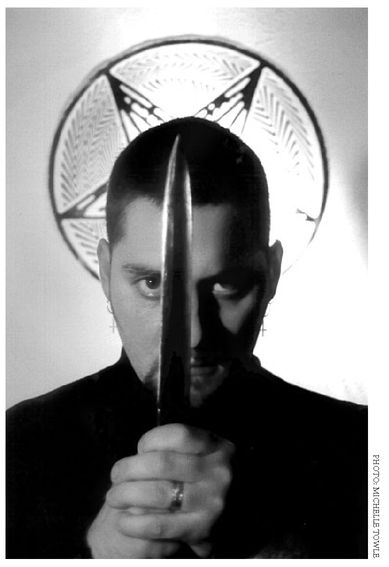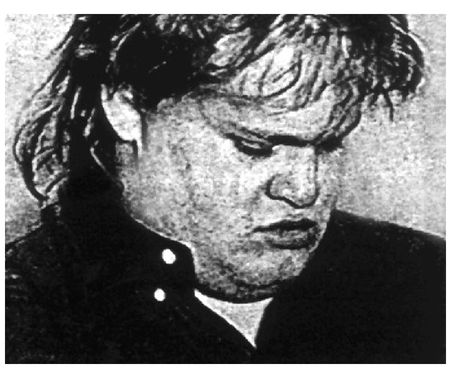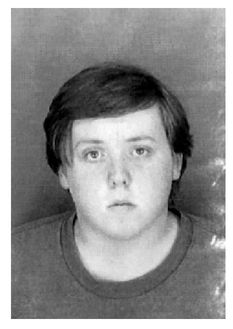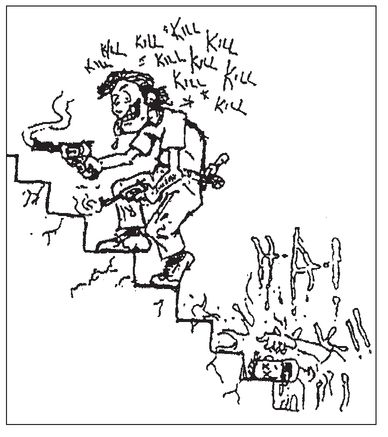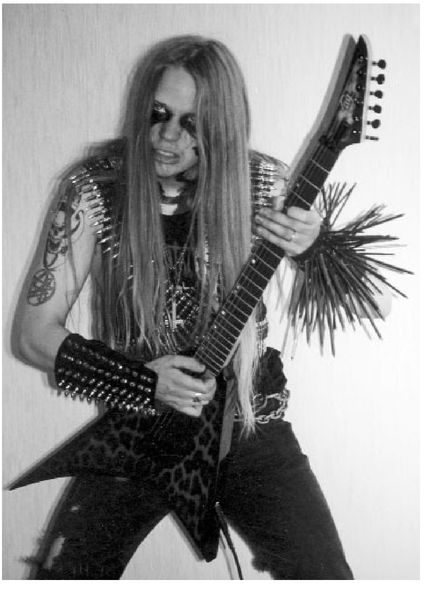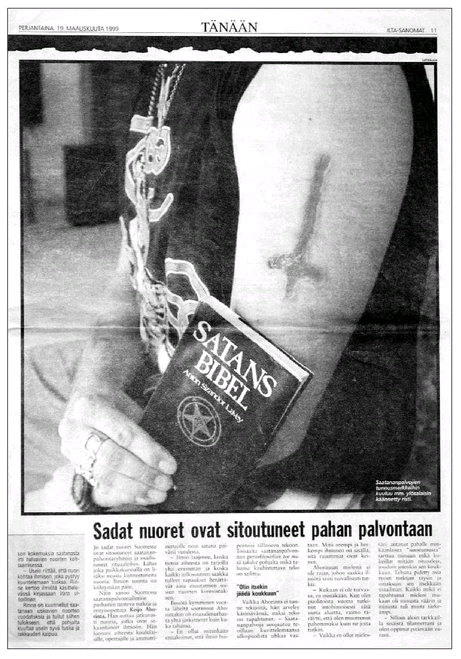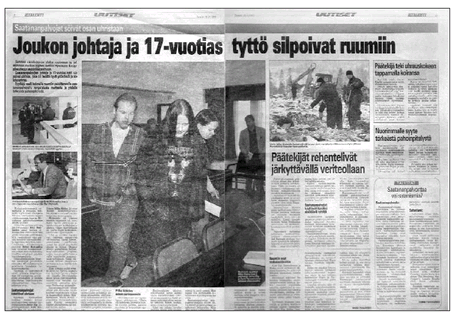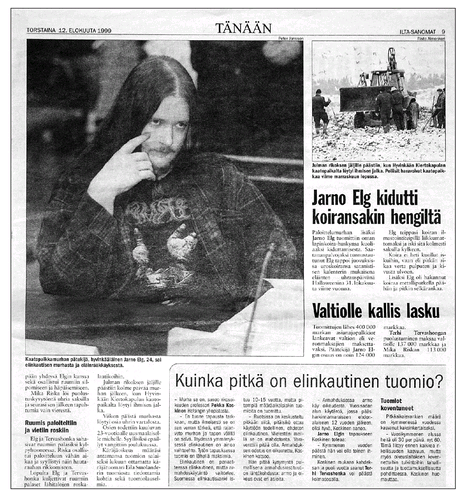IN THIS YEAR TERRIBLE PORTENTS APPEARED OVER NORTHUMBRIA AND SADLY AFFRIGHTED THE INHABITANTS: THESE WERE EXCEPTIONAL FLASHES OF LIGHTNING, AND FIERY DRAGONS WERE SEEN FLYING IN THE AIR. A GREAT FAMINE FOLLOWED SOON UPON THESE SIGNS, AND A LITTLE AFTER THAT IN THE SAME YEAR ... THE HARRYING OF THE HEATHEN MISERABLY DESTROYED GOD’S CHURCH IN LINDISFARNE BY RAPINE AND SLAUGHTER.
—THE ANGLO-SAXON CHRONICLE112
LORDS OF CHAOS
IN THE CONSCIOUSNESS OF FANS OF INTENSE, CUTTING-EDGE MUSIC, “BLACK METAL” has become synonymous with Norway. This is understandable, as the events there received a significant amount of media attention through articles in Kerrang!, Spin, Fortean Times, the Manchester Guardian, and other papers and magazines around the world. What few commentators realize—except those immersed in the Black Metal underworld—is that Norway is far from unique. Black Metal is a worldwide phenomenon, and in many parts of the globe it is just now gaining popularity and momentum. Like an unquenchable forest fire, spreading beneath a cover of leaves and underbrush, the smoking embers in Norway created by the loosely-knit “Black Circle” began to surface in faraway places.
It has been demonstrated how the desolate soil of East Germany provided a paradoxically fecund womb for Black Metal ideology to blossom into Absurdist crimes—all that was needed was fertilization by way of an example set by Scandinavia. They are not the only ones. Restless youth around the world long for a symbolic identity to join with, one that provides catharsis for their rebellious impulses. The manifestation of such energies often produces jolting results. What follows is a selective, country-by-country scorecard of the unfolding mayhem related to Black Metal, either in actuality or in spirit.
SWEDEN
A considerable cooperation and cross-pollination occurred between the Swedish and Norwegian Black Metal scenes. Most of this centered around the activities of Øystein Aarseth and his Deathlike Silence record label. Various key players from Sweden would visit Oslo on occasion, hang around the Helvete shop, and thus an alleged Swedish “Black Circle” eventually developed in a parallel fashion with their neighbors to the west.
SWEDISH HEADLINE:
“HE GAVE THE ORDER FOR ARSON”
The first documented Black Metal transgression in Sweden took place under the direction of Varg Vikernes when the 18-year-old future mental patient Suvi Mariotta Puurunen attempted to burn down the house of Christopher Jonsson on July 26, 1992. While the crime didn’t amount to much, her demented diary provided ample fodder for the media’s later portrayal of Vikernes as the perverse persona “The Count.” Puurunen was later brought in to testify during the trials in Norway of Vikernes and others.
“IT”: THE EVIL DWARF OF ABRUPTUM
A few short months later, on Halloween night in the town of Finspång, a party took place. All Hallow’s Eve is considered one of the more important Satanic holidays, and the celebration was allegedly attended by members of two of the most well-known Swedish Black Metal music groups, Dissection (who in fact predate the modern wave of Scandinavian Black Metal by a few years) and Abruptum. The latter group consists of the bizarre duo “Evil” and his accomplice “It,” a dwarf who asserts he adopted his pseudonym because he was so evil he could no longer be considered human. Both bands are often referred to as central forces in the Swedish Black Circle. During the course of the night’s merry-making, an 18-year-old in attendance named Linus Åkerlund was instructed that he should prove to the others he was capable of killing without compunction. Attempting to fulfill the directive, he attacked an innocent 63-year-old man, stabbing him repeatedly in the neck. The elderly man nearly died from blood loss; his attacker received a four-year prison sentence. Åkerlund served two years of his sentence and was released. He claims today he never committed the crime. In a separate incident, one member of Dissection was ordered to serve four months in jail for the desecration of 250 graves.

DEICIDE LIVE
In early December of 1992, Deicide, the Satanic Death Metal band from America, was on tour in Europe. They played in Oslo and shortly afterward in Stockholm, Sweden, at the Fryshuset club. Before they had taken the stage, an explosion went off by the fire exit of the venue, knocking out an entire wall and effecting major structural damage. A number of people were injured, though no one seriously so. It was first speculated that the Swedish Black Circle might have been behind the bombing, either as an attack against Deicide, who they may have considered rival Satanists, but more likely directed at the opening band Gorefest, an antiracist and politically correct Death Metal group. Further investigation of the matter raised serious doubts whether the bomb could have been placed by anyone connected to the Black Circle. When Deicide played in Oslo a few nights earlier, many in the Black Metal scene attended, and Øystein Aarseth was even the DJ at the concert. The Norwegians, at least, approved of Deicide’s Satanism and got along well with lead singer Glen Benton. The clue to the Stockholm bombing may have come shortly afterward, when death threats were made against Deicide prior to their U.K. appearances by an organization calling itself “Animal Militia”—a radical anti-vivisectionist group. Their threats were specifically aimed at Benton himself, who had previously advocated the torture and sacrifice of animals in Satanic rituals, and claimed to regularly take part in such activities himself. In the death threat sent by their “Manchester cell” to Benton, they began it with the sentence: “Stockholm was just a taste of what is to come.”
2 Given this evidence, and the fact that bombings have not been the usual
modus operandi of Scandinavian Black Metalers (although Vikernes later did steal 150 kilos of dynamite and other explosives, which were found in his apartment at the time of his second arrest), the likely suspects for the Deicide show detonation would be allies of the Animal Militia.
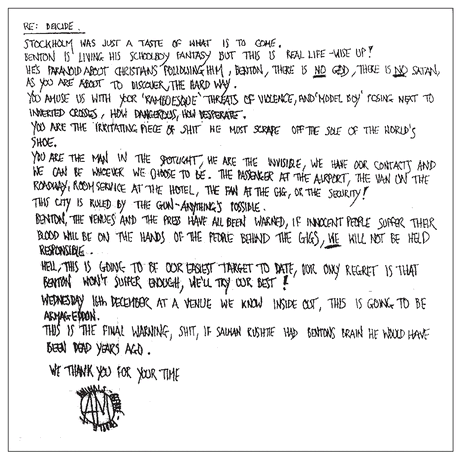
ANIMAL MILITIA DEATH THREAT
The Swedes did, however, quickly take up their own firebrands after the example set by Vikernes and others in Norway. About a month after Vikernes had publicly revealed the connection between Black Metal and church burning in the mass media, on February 7, 1993, the Lundby New Church in Sweden erupted into flames. Built in Gothenburg in 1886, the giant church was famous for its stellar acoustics and the many recordings made there. Ironically, an obsessive strain of music fan would attempt to destroy it. Three males, all about 18 years of age, eventually received two- to three-year sentences for arson. The same night also witnessed the vandalization of another Christian building not far from the Lundby New Church.
Later that year, on the 3rd of July, another church was attacked. The Salabacke Church was a wooden building erected in 1957, approximately forty-five feet high. A fire was started from solvent-soaked papers placed against the outside of the church. Due to the wood construction and the building’s height, the blaze raged out of control, completely destroying the church organ and much of the building’s contents. The church silver, pulpit, and altarpieces were blessed enough to survive. Two 15-year-old girls were arrested, but their young age meant they would only be confined to youth homes by the state. The arsonists declared they had committed their act as a salute to Varg Vikernes and to hail Satan. They had planned to continue burning churches and to threaten priests. Beyond having to pay a joint fine of 75,000 Swedish Kronor (approximately $9,400), one of the girls, Alexandra Jansson, clearly received no rehabilitation during her time as a ward of the state. She was later implicated in grave desecrations, death threats, and violence against civil officials in 1995 and ’96.
Another antique house of worship, Föllinge Church, had served the Christian community since 1815—until drunk and drugged-out Death Metal musician Stefan Dahlberg set the wood building alight on July 17, 1994. The 19-year-old youth was ordered to pay 50,000 Kronor ($6,200) in damages and confined to a mental institution. Besides the arson, Dahlberg was also found guilty of thirty grave desecrations.
Others directly involved in Swedish Satanic bands have attempted to cause disruption with varying degrees of violence. One of the members of Black Metal band Algaion, singer Mårten Björkman, was convicted with a one-month sentence for setting an old building on fire. Far more terrifying was the action which took place on February 22, 1995 in the city of Linköping, when three youths between 16 and 18 years old went on what they termed a “niggerhunt.” Wielding an axe and two machetes, they terrorized a black man. Two of them had also attempted to burn down a church a few weeks earlier, but were unsuccessful and caught by the police. Involved in both crimes was “Belfagor,” a member of the Black Metal band Nefandus.
The racist attack of Belfagor and friends was not unprecedented, although it was crudely and haphazardly executed. A few years earlier Sweden had experienced the campaign of the so-called “Laserman,” a clandestine assassin armed with a laser-scoped firearm who perpetrated at least ten murders or serious woundings of male immigrants and non-white citizens.
The most recent crime report from Sweden which received media attention occurred in mid-1996. In late July of that year, two males burglarized the sepulchral chapel in the town of Köping. Once inside the chambers, they found the room for the dead awaiting burial and managed to lift off one of the coffin lids, at which point they proceeded to paint Satanic symbols on the corpse. They also stumbled upon the clever notion of switching the names on two of the coffins awaiting interment. The authorities only figured out about the name swap later—after this small detail had caused the burial of the wrong person at a funeral.
Though the number of serious offenses may be lower, Sweden rivals Norway in the scope of atrocities related to Black Metal. While most of the Norwegian bands have now evolved past their earliest primitive obsessions with exemplifying “pure evil,” their Swedish cousins appear to remain attracted to such concepts. The main personality in Abruptum, “It,” even claims to have personally conceived the entire idea for the “True Satanist Horde,” which in turn inspired the formation of the Norwegian Black Circle. “It” insists that he and his allies will carry on in the original spirit of such efforts.
SWEDISH HEADLINE: “DEVIL WORSHIPPER BURNED DOWN THE CHURCH?”
Beyond those who actively take part in it, the Swedish police seem to be the only others who know what the Black Circle really is about in practice. The mayhem in Sweden has not abated over time, and may even overtake that of Norway in terms of sheer violence. On December 18, 1997, a 20-year-old Swedish “Satanist” was arrested in connection with several murders. According to the media (the police are reluctant to give out information), this might be the begin-ning of an internal “house-cleaning” of the Swedish underground in a similar way to what occurred in Norway. Varg Vikernes is seen as a probable influence.
SWEDISH HEADLINE: “CHASED BY THREE IN AXE DRAMA”
The police originally raided the home of the man for suspicion of abusing his girlfriend. In his apartment in the south of Stockholm, the police found a pistol with live ammunition and a human skull. They also found a so-called “ritual room” with an altar, skeletal remains, and “Satanic symbols.”
In connection with the raid, the police learned that the man had “claimed responsibility” for a murder committed in Gothenburg (or more likely boasted of it, given the behavior of other Black Metal criminals). According to the Swedish tabloid Expressen, the murder in question is an unsolved case concerning a teenage girl who was found undressed and dead in a graveyard in the summer of 1994.
Furthermore, the young man is now under suspicion of having killed a 37-year-old man from Algeria. The man was killed in a park in Gothenburg in July, 1997. The police believe that the 20-year-old might have killed more people. They later charged him with the suspected murder of a 16-year-old girl, Malin Olsson, killed on July 23, 1994—the exact same month and day of the murder in 1997.
SWEDISH HEADLINE: “THE CHURCH IN ASHES”
The young man had been in trouble with the law before. A few weeks before his arrest, he was charged with assaulting two men and a woman outside a restaurant in Gothenburg. The woman recalls that the man screamed: “Sieg Heil! Shall we slaughter people?” She also described him as a leader for a group of other young people. “They were like trained dogs. He pointed and told them to stand to attention, and they obeyed,” she said. Other witnesses describe the man as a “Satanist,” and say that he made Hitler salutes. The 20-year-old himself says he was too drunk to remember anything.
A second man has been charged in relation to the crimes, a 22-year-old who was alleged by the Swedish media to have been a close friend of Varg Vikernes. He is described as a “star in a Satanic rock band” by the press. This is, in fact, Jon Nödtveidt of the group Dissection, who may well be the source of the following quote from Slayer magazine in 1995, which was attributed to an anonymous member of the band:
...there are far more evil things to do than just bragging about church fires! Wait and see... Our empire seeks its senses in the darkest depths of mankind’s senses. What is hidden, but nevertheless existing. It cannot die! I don’t think that the Black Circle should be a fan club for Black Metal, it’s not about that...
3WANTED: JESUS
FRANCE
There are no reports of church burnings in France—yet. If the swelling interest in Satanism and Black Metal continues there unabated, anything is possible. The music received mention in a spate of newspaper articles which appeared in early 1997, focusing on connections between Satanic youth groups, Black Metal, and extreme factions of the right wing. While the accelerating media coverage resulted in a typical overreaction and a tendency to draw correspondences and conclusions that may have been unwarranted, there is no doubt that a number of bizarre actions did take place.
On the night of June 8, 1996, a desecration took place in the cemetery of Toulon. According to
L’Express magazine, four youths exhumed the cadaver of Yvonne Foin. After liberating the body from its twenty-year rest beneath the earth, they rudely planted a cross in the center of her heart. Two of the desecrators, Anthony and Christophe Mignoni, both age 20, were known fans of Black Metal. Police soon raided Antony Mignoni’s apartment and discovered certain tracts and pamphlets among his belongings.
L’Express drew particular attention to a leaflet with a unflattering portrait of Christ and the caption: “Wanted for Crimes Against Humanity: Jesus (AKA the Christ). He is accused of initiating the persecutions and murder of millions...”
4 The leaflet is a publication of
Napalm Rock, an underground magazine dedicated to heathen and revolutionary music groups opposed to the current political system. Napalm Rock is connected with the Nouvelle Résistance (New Resistance), a political group founded by Christian Bouchet.
In “another unsettling discovery,” the magazine reports that desecrator Anthony Mignoni is also a member of the French Black Metal band Funeral, in which he uses the pseudonym “Hades.”
5 Interviewed in an alleged neo-Nazi fanzine,
Deo Occidi, he is reported as stating:
I have created Funeral in order to spread my ideas based on the destruction of the Jewish, Christian, and Muslim religions, and on the purity and supremacy of the true Aryan race. ... The spirit of Heinrich Himmler will not die. We are the elite of the superior race. Under the sign of the SS, we will triumph. Loyalty and Honor. Sieg Heil!
6FRENCH GRAVE DESECRATORS
Later in the interview, he claims to be involved with an occult group calling itself “The Sacred Order of the Emerald.” Supposedly dedicated to Lucifer, the group was created by someone named “Antitheos,” who turns out to be none other than fellow desecrator Christophe Mignoni, operating the “Order” out of his parent’s home. The fanzine also provides evidence that the Mignoni boys paid regular visits to the graveyard. The interview is illustrated with a poorly reproduced photograph of two males in corpsepaint makeup, standing before a cemetery tomb with a Nazi armband in clear view.
ORDER OF THE EMERALD
A follow-up article in
L’Express reveals further evidence which “confirms the ideological references of the young ‘devils.’”
7 Some months after the original despoilment of Yvonne Foin’s corpse and subsequent raid of Mignoni’s apartment, grounds-keepers at a military area on nearby Saint Madrier peninsula discovered an odd sack under a pile of rocks. Upon closer examination, the contents of the sack were found to be photos of youths dressed in trenchcoats and wearing sinister face paint, manuscripts from the Sacred Order of the Emerald, and a number of neo-Nazi publications. The bag was later traced back to Christophe Mignoni. Police theorize the sack was hidden by his brother David, in a panic after the arrest of his sibling and friends.
L’Express then goes on to imply the desecrators must have been involved with all the groups whose literature was found in the sack, including the Charlemagne Hammer Skinheads, the French Nationalist Party, and the inner circle of Nouvelle Résistance. Such speculations seem unfounded. The citizens of Toulon should be more worried that some of the tracts previously in the hands of the “little devils” also included instructions on homemade bombs, Molotov cocktails, and explosive lightbulbs. If no one else, at least the youths’ patron deity Lucifer (the “light bringer”) would be impressed.

FATHER UHL
Sensational tales in the press didn’t stop with the Toulon affair. In an act recalling the brutality of the Norwegian killings a few years earlier, on Christmas eve, 1996, a 19-year-old in Mulhouse paid an unexpected visit to an elderly priest in the town. The youth, David Oberdorf, had professed his faith before the same clergyman in the Saint Adelphe Church some years earlier. Wielding a recently purchased dagger with a twenty-centimeter blade, Oberdorf appeared at the residence of Father Jean Uhl. Once face-to-face with the priest he declared, “I am possessed by the demon—I must annihilate men of religion!”
8 Father Uhl tried in vain to dissuade him from committing an irreparable act, but Oberdorf would not be deterred from his unholy mission. The body of the Church Father was later found dead, stabbed thirty-three times. Prosecutors speculated the killing was done as an attempt “to symbolize the death of Christ.”
9 Whatever the motive, Oberdorf inflicted a number of wounds on the body after it was dead, including peculiar incisions on the insides of the priest’s palms in the shape of a “V,” or what may have been unsuccessful attempts to carve a pentagram. A legal official noted, “It’s not a matter of defense wounds—these are scarifications made
after the death.”
10The report in the
France-Soir paper describes Oberdorf as an “impressionable youth of modest intelligence,” who had previously attempted suicide.
11 He had also placed numerous anonymous harassing phone calls to Father Uhl prior to the murder. The teenager’s room was described as quite ordinary, except for a collection of disturbing compact discs. His neighbors had often noticed sounds blaring from his room, “gnawing music, hard and stressful, which one would hear late at night”—not a bad description of standard Black Metal from an unfamiliar listener.
12 Other media reports referred to the youth as a fan of “Viking music.” Oberdorf had no girlfriends, but spent time with a few other male teens. One, 18-year-old Stephane Fest, was later arrested after police found he had hidden the murder weapon for Oberdorf. Both youths routinely dressed in black. Investigators also found links between Oberdorf and Toulon grave desecrator Anthony Mignoni, who was thought to be the “initiator of David Oberdorf.”
13 Mignoni, having served the sentence he received for the corpse defilement of the previous summer, could not be directly implicated in the murder of Father Uhl as he had a sound alibi. He had been at the home of his grandmother that evening.
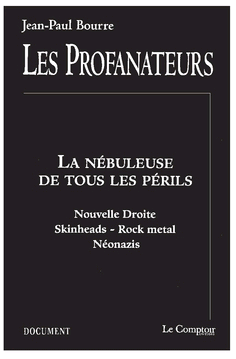
FRENCH ALARMIST BOOK
The France-Soir piece on the Mulhouse killing also mentions the right-wing influences which pop up in Black Metal, and on the same page of the paper one finds an article titled “From Lucifer to the Extreme Right: The Skins” describing a recent French book by Jean-Paul Bourre, Les Profanateurs (The Desecrators). This 200-page exposé, by the previous author of The Luciferian Sects, spins tales of a dubious web joining skinheads, Black Metalers, drug use, neo-heathenism, and the right-leaning cultural intellectuals of the “Research Group on European Civilization.” The fascination surrounding the grave of Jim Morrison of the Doors (buried in Paris’ famous Pere La Chaise cemetery) and those of other notable personalities is also inexplicably discussed in one chapter. Les Profanateurs desperately attempts to pull all these disparate elements into a sinister scenario in hopes of alarming its readers. It makes the questionable assumption that anyone interested in vaguely similar ideas—even when of the broadest sort, such as “neo-heathenism”—must therefore be part of a de facto hidden conspiracy. Such grand conspiracies may make good fodder for the front pages of tabloids, but the reality of the situation is far less organized and interconnected than such journalists argue. The same was certainly true in Norway.

CHRONOLOGY OF KERRANG! ARTICLES
ENGLAND
Black Metal in the United Kingdom erupted in two different realms. Underground fans of the music inaugurated a series of church attacks in emulation of their Norwegian hero Varg Vikernes, and almost caused Black Metal music to be banned in Britain as a result. On the other hand, homegrown English Black Metal achieved far greater popularity than the genre had anywhere else in the world, entirely due to the success of one band. Both strata in the U.K. scene had a small bit of common ground.
BRITISH HEADLINES
By the spring of 1994, reverberations of the church burning epidemic in Scandinavia had been heavily covered in the British press, from Kerrang! magazine to the Manchester Guardian newspaper. Kerrang! in particular had devoted steady, melodramatic coverage to the Norwegian scene, regaling its readers with the latest shocking actions and pronouncements from Øystein Aarseth, Varg Vikernes, Fenriz of Darkthrone, and others. As a result, young fans were excited by Black Metal and well aware of the harsh ideological rhetoric that came with it. Vikernes’s statements—in particular, his claim the church arsons were acts of heathen terrorism—made a strong impact on a small clique of teenagers from the town of Tunbridge Wells in Kent, England.
PAUL TIMMS
The group of friends, led by 18-year-old Paul Timms, formed the nucleus of an underground Black Metal band dubbed Necropolis. Other members included Dave Wharton, a 22-year-old postman, Mark Reeves, also 22, and Kevin Mooney, a 21-year-old engineer for British Airways. Timms’s girlfriend later stated that the band was created after inspiration from the Norwegians.
Kerrang! also believes that the group’s campaign of “attacking the church, with whatever means possible, was to earn respect and notoriety from their idols.”
14 It certainly gained more attention than they would ever receive for their music, as Necropolis does not appear to have recorded a note.
Beginning in April, ’94, members of Necropolis carried their impulses to fruition, and began a desecratory assault against churches and cemeteries in their area. They would knock over or break as many as sixty headstones in a single night. Graveyards in Rusthall and Tunbridge Wells were hit first. On Easter the assaults accelerated with the desecrations of St. Peter’s Church in Southborough and St. Mark’s Church in their hometown. In the latter instance windows were shattered, the altar destroyed, prayer books shredded, and artifacts upturned. Timms later commented, “We wished we had burnt it afterwards.”
15 He also claimed the group would have targeted larger churches if they’d only had access to explosives. Desecrator David Wharton said the actions were carried out in the early hours of the morning with the group outfitted in camouflage clothing. Timms stated he felt nothing for those buried in the cemeteries or their living relatives, and justified himself: “We are Satanists. We believe it is revenge against Christians. They destroyed pagan boundaries and built their churches on top of them.”
16 Such words demonstrate an obvious emulation of Varg Vikernes. Vikernes is quoted in the same
Kerrang! feature as saying, “No one can stop the church burning. And if these people claim to be influenced by me, then that’s fine.”
17Following the initial graveyard and cemetery ransackings, a week later the group again attacked the church in Southborough along with St. Peter’s Church in Fordcombe. Their final assault, called “an orgy of desecration” by one U.K. paper, resulted in the vandalization of graves in Speldhurst, Groombridge, and Frant.
18 Not only were headstones toppled over, but those which were in the shape of crosses were ripped up, inverted, and left standing upside-down. Timms and his fellow musicians were finally arrested in simultaneous police raids on May 27th. The authorities were acting on an anonymous tip, which may have resulted from someone overhearing Timms talk of the crimes to his girlfriend in a pub. At first police only brought in Wharton, Reeve, and Mooney, unaware of Timms’s connection to the group. However, in the raids on their homes, investigators found a homemade poster of Necropolis depicting the four members. Based on this they quickly realized one of the criminals was still probably at large. They arrested Timms two days later.
During one of the court hearings, presided over by a Catholic judge, Timms donned a T-shirt from the English band Cradle of Filth which featured the slogan “JESUS IS A CUNT” across its back. The youths expected to receive assignments of community service for their actions, but ended up with two-and-a-half year jail sentences. When initially in custody and asked by the jail wardens what he wanted to eat, Timms replied: “A bible!”
19 He starved himself for four days before relenting with his dietary request. Damage for the crimes was assessed at a minimum of £100,000 ($160,000), possibly much higher.
Timms’s girlfriend, 16-year-old Justine Turnbull, described how he would talk to her about the plans of defiling the churches:
He used to say that if he didn’t do it, then he would be a hypocrite. Cradle of Filth talk about doing all this stuff against Christianity but they haven’t actually done it, whereas Paul put what he believed into practice. I admired that in him. I still do.
20
When asked if she thinks he and his bandmates took it too far, she states simply: “No.”
21 The Reverend John Banner of Tunbridge Wells, a former exorcist and friend of Timms’s mother, was vociferous in his outrage at the acts of destruction:
This is the first time I have come across a group who have seen, by virtue of a cult, what they have to do and go and do it like a military operation. Their acts were committed to cause the most horrific offence to innocent people, arriving at their churches for Pentecost.
22CRADLE OF FILTH
Rev. Banner subsequently used the example of the desecrations as justification for attempting to ban Black Metal music in the U.K. altogether. “I have no doubt the Black Metal and Death Music and its teachings is 95 percent to blame for this. It has to be stopped...”
23The Kerrang! article points out that Timms was allegedly in regular contact with U.K. Black Metal bands Gomorrah and Cradle of Filth. The media excitement over the Tunbridge Wells vandalism soon developed into feature articles on the horrors of Black Metal music itself, and Cradle of Filth was generally singled out for attention. In reality, the band had no connection to Paul Timms whatsoever, although he had spoken to them on one occasion after a concert. Cradle’s singer Dani recalls:
I met the guy once and he was really polite. It was quite weird because he was in awe of the band. We’re quite down-to-earth people, there’s no façade there, but he was like that, in awe of us. He came up to us at a show, and you knew he was peculiar and that there was something wrong there. I didn’t pay much attention to it, really. When I was young and not appreciative of places like graveyards, etc., I remember being drunk with punks in the middle of a town and—it was a childish and immature thing to do—spray painting tombstones and kicking them over. This is all they did. They got pissed and destroyed a few graveyards and subsequently they were in prison for it. The hoo-hah died down pretty quickly over it, and that sort of thing isn’t good for a band of our stature anyway because people get the whole ideology wrong straight away. This is why we kind of branched off from the Norwegian thing because as soon as you’ve got the Black Metal tag, people assume you are a fascist and you’re into Devil worship, which can be linked to child abuse.
24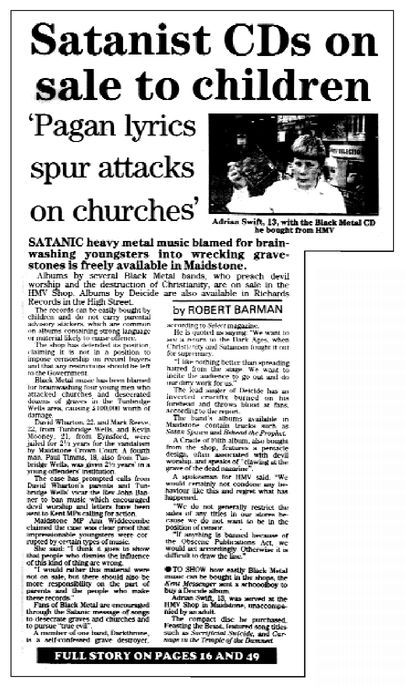
THE BRITISH MEDIA REACTS
Cradle of Filth began to make some waves in the Black Metal scene after the release of their first album The Principle of Evil Made Flesh. It was at this time that Paul Timms was allegedly in “awe” of them. The band began fairly quickly to distance themselves from their musical peers in Scandinavia by employing evocative aesthetics in the album artwork, and covering more romanticized themes drawn from nineteenth century literature and poetry. They wore the requisite Black Metal corpsepaint, but began to cultivate an atmosphere befitting of Hammer horror films rather than the one-dimensional “evilness” projected by other groups. Later releases Vempire and Dusk and Her Embrace brought the group to a exponentially increasing audience.
Cradle of Filth has many critics in the Black Metal scene who consider them “fakes” or “sell-outs,” and it is true some of their publicity efforts have made them look silly. The band is not a necessarily a harmless theater troupe, however, and comments made by Dani and his bandmates in glossy U.K. Rock mags put things in a different light. “Think of all the people like Countess Bathory and [mass child murderer Gilles] de Rais and the Marquis de Sade. All these people had money, and that’s what allowed them to do what they did. Don’t think for one minute, if we had access to those opportunities, we’d all do whatever occurred to us. We’d do worse.”
25 A few paragraphs later he elaborates on such urges, “Put it this way, if I was in control of the world, I would wipe out half of it instantly and indiscriminately without any remorse ... I’d nerve-gas half the world.”
26 Combining such misanthropic visions with alluring graphics and sensual music, Cradle of Filth is reaching many more listeners beyond the typical Black Metal audience with its message. They wield considerable influence over the next generation of young musicians, writers, and artists. Guardians of morality are upset by the sounds and statements of groups like Cradle of Filth, but there is no end in sight. The future is destined to bear even more ominous fruit.
EASTERN EUROPE—RUSSIA & POLAND
Along with every other Western pop culture phenomenon, Heavy Metal made its way east, achieving added impetus from its forbidden allure in a totalitarian state. The belief in extreme music as “anti-system” has already been attested to by the members of Black Metal band Absurd, who reside in the territory that was once East Germany. Similar feelings must be commonplace in Poland, Russia, and other areas formerly under the communist yoke. Contemporaneous with its development in Europe and America, Death Metal rose to prominence amongst Russian youth by the the first half of this decade. Not as musically extreme as its Western counterpart, it more than compensated by courting the forbidden in other respects. News of the new wave of Russian Metal first reached Western readers in a
Wall Street Journal article on February 18, 1993. Titled “Mayor of Moscow: Spider the Metalhead is Ready to Serve,” the piece revealed the strange, newfound allegiance between violent metalheads and the radical political parties of the right wing, or as the article describes, “nationalistic former Soviet Communists, in their cheap polyester suits, and Russia’s trash rockers, in black leather and chains.”
27
KORROZIA METALLA
In a strange political twist, an extremist racial group, the National Radical Party, nominated the singer of Metal band Korrozia Metalla as a mayoral candidate in Moscow. His name is Sergei Troitsky, AKA “Spider,” and he normally dresses in black T-shirts, jeans, and jackboots. Korrozia Metalla’s most popular song among fans is called “Kill the Sunarefa,” a slang term for darkly hued minorities from the south. Fans call out for the song at concerts, which are frenzied spectacles of more than just amplified cacophony from the bands. Additional titillation regularly comes from naked females dancers who prance and masturbate on stage beside the musicians. After one such show, kids in attendance swarmed outside, set fire to kiosks operated by minorities, and turned over parked cars.
KORROZIA IN CONCERT [NOTE EFFIGIES ON SIDES OF STAGE]
A September, ’93, feature in
Penthouse magazine included not only photos of sleazy live Metal shows (memorably exemplified by a shot of the dwarf singer of one band, onstage in his underwear, cavorting with a naked stripper) but also translations of the liner notes to the
“Sunarefa” number: “We dedicate this song to all patriots who wage war against the southern Asiatic animals who poison our lives with their rotten fruits and vegetables and rape our women. Death to the
Sunarefa is our anthem.”
28RUSSIAN RIGHT-WING BOOKLET
Sergei Zharikov, youth advisor to the National Radical Party and publisher of a paper called
Raise the Axe, believes a magnetic figure like Spider may have serious chances in the political world. “[He] is charismatic, and he knows the mood of the street. Two million listen to his records.”
29 Zharikov’s beliefs are probably similar to many of those few million who buy the albums: “We respect might and power, and we do not like all the Western pop that has clogged the airwaves.”
30 He also admits concern for the edge the Party straddles in courting the energies of the angry Metal audience: “Our greatest difficulty is to keep the young from extremism and violence ... it could all end in anarchy...”
31The political parties cultivating the Russian bands eschew any kind of Satanism, due to the Christian nature of their overall constituency. Nevertheless, an examination of record covers by Korrozia Metalla and other groups reveals occult symbolism and upside-down crosses alongside Nazi banners, hooded Klansmen, and gratuitous illustrations of bloodthirsty violence.
RUSSIAN RIGHT-WING BOOKLET
HITLERIAN PRESS RELEASE
The union of these strange bedfellows is demonstrated in the right-wing newspaper
Den (“Day”), which runs a music column alongside its standard political commentary and photos of prisoners of war being marched to internment camps with the caption “This is what we will do to the democrats.”
32 The back page feature dubbed “Rock—The Russian Resistance” tries to bring in a younger readership, hyping the music of bands such as Korrozia Metalla, Exorcist, and Death Vomit. The Deputy Chief Editor of the paper, Vladimir Bondarenko, explained, “I’m not exactly a big fan of Heavy Metal, but you can’t deny that it’s an intrinsic part of Russian culture. ... We’re opposition and they’re opposition. We need them; they need us.”
33Neo-paganism and occultism have crept into certain areas of the Russian far right, although the large majority remain loyal to the beliefs of the Orthodox church. However, books on runes and Nordic history have begun to appear from right-wing imprints, and the youth in particular are ripe for an appeal cloaked in barbaric Viking imagery. The name Russia itself, after all, comes from the predominantly Swedish Viking tribe of the Rus who settled the region in the year 852 C.E.
GRAVELAND FOLLOWING THE VOICE OF BLOOD
It is difficult to gauge how the situation in Moscow and elsewhere has evolved since 1993. Things take longer to seep into Eastern Europe and take hold, although there is a rabid underground waiting to swallow up anything exciting from the West. The cassette kiosks which sell bootleg music tapes have been providing Black Metal for years, and undoubtedly the disenchanted there find much in it to rally around. When Russian bands—already happily using the stage as a platform for racism and calls to arms—decide to integrate the uncompromised grim outlook of Black Metal into their oeuvre, the results could be volatile. A Russian Rock critic already commented in 1993 that “an atmosphere of pogroms”
34 was increasing among the youth. Flyers have circulated in 1994 for one band calling itself “SS Hitler Panzer Division.” The members have adopted pseudonyms in typical Black Metal style, although with a German twist: “Fuhrer” is the lead singer (or “orator” as their press release claims), “Dr. Goebbels” plays “anti-aircraft drums,” and Himmler is present on “attack bass.” The number of even more extreme bands incubating in the fertile and fetid post-communist Russian underground is anyone’s guess.
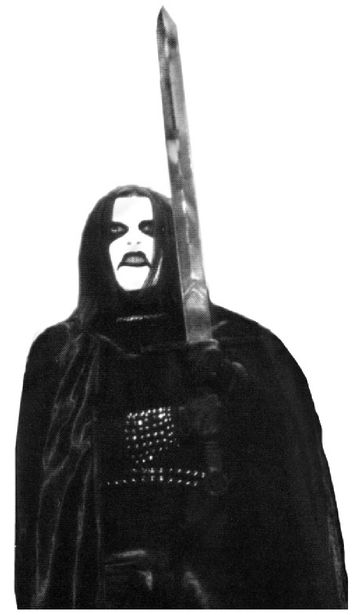
GRAVELAND
Outside observers might dismiss the images of these Metal bands as nothing more than exotic attempts to attract attention. But Russian bands like Korrozia Metalla feel they are involved in something much more serious than mere hedonism or entertainment. Spider matter-of-factly states, “U.S. Rock is a tea party. Here the fight is for real.”
35 In a style similar to some of the pretentious exclamations of Norwegian Black Metal that would be heard a few years later, he calls on his audience to “join forces and rebuild the empire. We have a great task ahead of us.”
36Russia is not the only place on the eastern edges of Europe where such ideas have taken root. Poland, too, has a rapidly growing Black Metal scene which is closely linked to the rise of extreme right-wing activity there. The most visible band from that country is Graveland, led by the outspoken frontman Robert Fudali, AKA “Darken.” Musically Graveland has received rave reviews from Black Metal fans worldwide, but their political statements have engendered some negative reactions. In published interviews, Darken explains his goals in terms similar to Spider of Korrozia Metalla: “I prophesy the coming era of the great rebirth of paganism, the rebirth of the Aryan Pagan Empire, stronger because of the experiences of the last two thousand years.”
37He is also unequivocal in his support of Adolf Hitler, stating, “Without a doubt, I belong to those who think Adolf Hitler is the biggest figure in European history... His ideas stir in us great admiration.”
38Graveland releases its music on a German label, No Colours Records, which also produced the album by Absurd. And like their German and Norwegian counterparts, the Polish Black Metalers appear to be moving from the realm of music into one of action. Reports of church burnings in Poland are filtering to the West, no doubt fueled by the anti-Christian statements of bands like Graveland. As Darken warns, “I would like to teach people to search for their true pagan personality and identity. The pagan spirit sleeps in every one of us; it is very strong but dormant. Once awakened, it shall resent and destroy that which denied it life all these centuries.”
39
UNITED STATES
AMERICAN BLACK METAL FANZINE PETRIFIED
The popularity of Black Metal in America has not yet reached the levels evident in Europe. There are far fewer bands, extremely infrequent concerts, and the genre has remained underground. There are a number of record labels attempting to change that, including Century Black (a division of Century Media Records), Necropolis, and a U.S. division of the French label Osmose. Century Black has released some of the more noteworthy Norwegian bands, including Mayhem’s legendary full-length De Mysteriis Dom Sathanas. Necropolis Records, run by Paul “Typhon” Thind, released Nordic Metal, a CD compilation dedicated to the late Euronymous. Thind claims close ties to the Swedish Black Circle or “True Satanist Horde,” and the label’s releases are almost universally of a vehement Satanic or anti-Christian nature. Their business appears to be thriving, despite a dearth of coverage in music magazines or any widespread store distribution.
An allusion to a more organized U.S. Black Metal movement appears in an old copy of the Florida fanzine
Petrified, which glorifies the more notorious members of the scene from Norway. A 1994 issue includes interviews with both Bård “Faust” Eithun, who states that homosexuals “are nice to put knives into,” and Varg Vikernes, who extols readers to follow the example he has set and “lay waste the Jews’ world.”
40 In the interview with Bård, the editor asks his opinion of the “new American Black Metal Circle,” to which Eithun replies: “I have to admit that I haven’t heard about this circle, but if it leads to any form of death or human suffering, I think it’s worthy.”
41GLEN BENTON OF DEICIDE
For the most part, there is little evidence any such American Black Circle exists, unless they have simply managed to thus far operate unnoticed. Fans of extreme Metal in this country are often far less intelligent than their Norwegian or European counterparts. The primary American interests outside of music include drugs and alcohol, neither of which played any significant part in the Norwegian Black Metal milieu. As a result, any antisocial actions are likely to be misdirected at best. The attempts to interrelate them into any kind of grand Satanic conspiracy are fruitless; the main similitude of these crimes lies in their irrational confusion.
Florida is also the home of Death Metal band Deicide, who have always projected a staunch image that is not far off from the “medieval” Satanism glorified by the early Norwegian scene. Singer Glen Benton branded an upside-down cross into his forehead years ago, and (to the obvious irritation of groups like Animal Militia) often advocates animal sacrifice in interviews. Allegedly the band’s albums have sold hundreds of thousands of copies worldwide.
In January of 1993, two 15-year-old boys in Vernon, New Jersey abducted and then sacrificed “Princess,” a neighbor’s dog. They ripped the animal’s tongue out and impaled the mangled creature on a large metal hook before hanging it in another neighbor’s tree. The youths later told police that their fascination with Deicide led them to kill the dog, and that they were listening to the band’s music prior to the act. One of the boys described the sacrifice to his lawyer as an “out-of-body experience.” Benton was quoted as stating he would not take any responsibility for the killing, but was not opposed to it. “I enjoy killing,” he told a New Jersey newspaper.
42COVERAGE OF THE EUGENE MURDER
Another crime related to Satanic Metal, and Deicide specifically, took place on April 10, 1994 in the city of Eugene, Oregon. A few minutes before midnight four teenagers, Michael Hayward, Johl Brock, Jason Brumwell, and Daniel Paul Rabago arrived at a run-down Dari Mart convenience store and initiated a robbery at the cash register using a 1.7 lb. metal bar as the weapon.
While Rabago and Brumwell stood guard, Hayward went into the rear cooler room, where a second store employee was restocking beverages. In a matter of seconds the female employee was lying on the ground, fatally beaten and stabbed to death. Before leaving the store the group brutally attacked another woman behind the front counter, although she survived the violent assault.
The youths were caught a few months later when detectives realized that a roll of Lotto tickets had been stolen from the store on the night of the murder, and these were later cashed in with the culprit’s name on them. There was ample evidence to convict the boys of their crime, and Hayward received the death penalty from the jury.
Civil lawsuits followed, wherein both the surviving store clerk and the family of the deceased claimed that the criminal’s behavior had been heavily influenced by the music of Deicide and Cannibal Corpse. Rabago had been recorded during his police interrogation as stating of the crime, “I did it in essence of Glen Benton and Chris Barnes [the lead singer of Cannibal Corpse].”
43 The youths had also allegedly been listening to Deicide music in a church parking lot shortly before the convenience store bloodbath. The civil suits were levelled mainly at the record labels of the bands, Roadrunner and Metal Blade. CDs, T-shirts, band photos, and “Satanic literature” seized at the youths’ homes were entered into evidence. The cases were settled out of court, with the record labels paying substantial sums while “expressly not admitting guilt.”
There are human deaths tenuously linked to Satanic Metal as well. In early 1996 in Arroyo Grande, California, a group of youths murdered another teenager, allegedly as a Satanic sacrifice done to receive blessings of power and success from the deity. The youths were fanatical Slayer fans. The drummer for Slayer at the time, Paul Bostaph, resigned from the band shortly after news of the murder made headlines. His reasons for leaving revolved mainly around artistic differences, but he was also uncomfortable with the band’s dark image. Not long after his departing Slayer, Bostaph made a remark about the teenage murderers in an interview: “I guess these guys were total Slayer fans. After hearing that, it totally made me glad I left the band. I don’t want the music I’m involved with, or I create, to influence anyone like that.”
44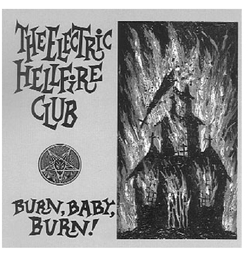
The propagation of anti-Christian sentiments goes beyond the Heavy Metal genre in the case of Wisconsin band The Electric Hellfire Club. Their music is a blend of Industrial electronics, Psychedelic keyboards, and Metal guitar riffs. Since their 1993 debut album,
Burn, Baby, Burn! (the cover of which featured a painting of a church consumed in flames), the band has extolled acts of Satanic crime by teenage psychopaths in their lyrics and offered exhortations to their listeners to continue such activity. One of their early anthems is “Age of Fire,” now a staple crowd-pleaser at their concerts. The lyrics ask:
THOMAS THORN OF THE ELECTRIC HELLFIRE CLUB
Synagogues and churches burning Can’t you see the tide is turning? How many fires will it take? Before you realize your god is dead...45
In light of the band’s underground popularity, it may not come as a surprise that some fans of the group have begun vandalizing churches. Singer and lyricist Thomas Thorn is obviously untroubled by such behavior. In a recent interview where he was asked about the church burnings in Norway, he stated:
I’m all for it. It’s certainly no coincidence that we had a picture of a burning church on the first album. A lot of people will say, “That’s a horrible thing to say! There’s a history behind the architecture, if nothing else.” Nobody said that when they were blowing up the Nazi eagles on the top of the Reichstag at the end of World War II. The missionaries who came and took away the Nordic gods and Scandinavian culture weren’t all nice guys who said, “Just come over to Jesus.” A lot of these people were doing it at sword point and saying, “Renounce your gods and attend this church—which we’re going to build on the holy place where we knocked down your temple.” There is a new generation reclaiming its ethnic spirituality. Part of reclaiming that is the recognition of centuries of oppression. For them, it’s a revolutionary act, it’s not an act of vandalism. It’s a statement. The church is the legacy of the people that stole their heritage. By all means—burn, baby, burn!
46CALEB FAIRLEY
Asked whether he would advocate Norway-style church burnings in America, he replied:
I wouldn’t condemn them, I’ll say that. I’m not going to jail because somebody says I told them to go out and burn a church. Somebody called me up and said, “You’re not going to believe this but two little kids were taken into custody in Jacksonville, Florida for spray-painting a church and they cited a band called The Electric Hellfire Club and a song called “Book of Lies” that says,
‘There’s a church across the street / Let’s spray paint the walls.’” I’ll say that brought a smile to my face and I certainly had pleasant dreams that night. There’s some people whose station in life is to do something stupid and rot in prison for it. Quite honestly, I’d rather have them burn down a church than kill their girlfriend. If people are bound to fuck up and be incarcerated for a stretch of time, they might as well do something worthwhile. Why not burn down a church rather than shoot a convenience store clerk? That’s my message to the youth of today.
47
Not all of the band’s fans are content to concern themselves with mere vandalism. The most disturbing crime connected to The Electric Hellfire Club concerns the case of Caleb Fairley, a teenager from King of Prussia, Pennsylvania, with a history of minor sexual misconduct. Fairley was employed at Your Kidz and Mine, a children’s clothing store owned by his parents. On September 10, 1995, he was the only one at the store, except for a woman and her young daughter who arrived to shop just before closing time. Fairley proceeded to lock the customers into the store, murder them, and allegedly violated their corpses before dumping them somewhere outside. He then immediately headed off to his scheduled entertainment for the evening—a concert of The Electric Hellfire Club. At the venue, Fairley approached Shane Lassen, the band’s keyboardist, and demanded plaintively, “Can you help me?” Lassen was slightly bewildered, and asked Fairley to explain. “I need help in establishing a more personal relationship with Satan,” he elaborated, and told Lassen how he had tried utilizing books like the Necronomicon and the Satanic Bible to no avail. Lassen would realize the fan’s attempts to please the Prince of Darkness had entailed much more than reciting spells when he read of Fairley’s pre-concert activities in the subsequent newspaper headlines. Fairley was charged with two counts of murder, robbery, two counts of aggravated assault, and “abuse of a corpse.”
Far more dramatic than any of the above scenarios is another story with roots in Florida. In the spring of 1996, a series of crimes began to take place in the city of Fort Myers. On April 13th, a group of male teenagers commenced a campaign of mayhem and terror with startling similarities in spirit to the Norse eruption in 1992–93. Calling themselves the “Lords of Chaos,” the cabal of six began their crusade by burning down a supermarket construction trailer. They followed this with the arson of a Baptist church. The terror spree escalated in perversity when the youths spread gasoline around a tropical aviary cage adjacent to a theme restaurant, then ignited the thatched-roof structure and watched the blaze exterminate the entire collection of exotic birds.
Things were just getting underway for the self-styled militia. The next attack was on a deserted former Coca-Cola bottling plant, where they arranged explosive propane tanks inside before retreating and tossing a molotov cocktail into the building. The structure was nearly obliterated while they observed the ensuing detonations from across the street. Only six days passed before they moved into action again, carrying out a masked armed robbery and carjacking in front of another restaurant.
The finale came on April 30th, which the astute reader will also recognize as the Satanic holiday of Walpurgisnacht. At 11 P.M. that night, the marching band director of their high school, Mark Schwebes, caught the boys on school grounds and confiscated the cans of peaches they were preparing to lob through the school windows. Halting them from an apparent act of surrealist vandalism, Schwebes ordered the boys to go home and warned them they would receive a visit from the school’s deputy the next day.
A few hours later that night, Mark Schwebes answered a knock at the front door of his home. Seconds after he had pulled open the door, a 12-gauge shotgun was blasted into his face. Three days later after the execution of Schwebes, police arrested key members of the group. At the time of the arrest they were headed out to rob a restaurant at gunpoint where two of the boys worked. The police stated they planned to kidnap the restaurant’s manager and shoot anyone who tried to interfere.
THOMAS TORRONE BOTTOM
CHRIS BURNETT,
CHRISTOPHER BLACK
After jailing those involved in the Lords of Chaos, investigators discovered more about the group. It consisted of Derek Shields, Peter Magnotti, Christopher Black, Christopher Burnett, and Thomas Torrone. The leader of the self-styled militia was Kevin Foster, an 18-year-old whom the others allegedly referred to as “God.” They each had reserves of weapons in their cars and houses. For the murder of Schwebes, Derek Shields had been the one to knock on the door—he was a member of the Riverdale school band and therefore could make sure it was his teacher who answered. As soon as Schwebes had opened his door, Shields gave Foster a signal to pull the trigger of the shotgun. Foster then allegedly unloaded a second shot into Schwebes’s buttocks because it was believed he was a homosexual. When Schwebes had caught them on the school grounds earlier that evening, it turned out they were in fact preparing to burn down the building (the canned peaches remain a mystery). Shields recently pleaded guilty to murder and will testify against two co-defendants in exchange for a life sentence without parole. In doing so he avoids the death penalty which his former associates are certain to receive.
Had they not been interrupted by the authorities, the “Lords” had more ambitious plans. They already decided upon their “ultimate crime of chaos,” a sinister strategy for their upcoming graduation night party at Walt Disney World.
48 Once inside the park they would steal life-sized cartoon character costumes. Thus disguised, they would stroll around the theme park, randomly murdering black tourists with silencer-equipped handguns. Ft. Myers Sheriff John McDougall stated he doesn’t believe the plan would have gone smoothly due to the strict security at Disney World, but that the Lords of Chaos would have reacted violently if anyone attempted to stop them. “They were going to make a strong statement at Disney. It would have been a bloodbath,” he said.
49 Sociologists might secretly hope the unexpected brutality of the Lords of Chaos could be traced to poverty or lack of edu-cation, but such explanations were futile. One of the boys charged in the murder of Schwebes was even a straight A student, recently awarded with a full college scholarship, and another had scored 158 on an IQ test.
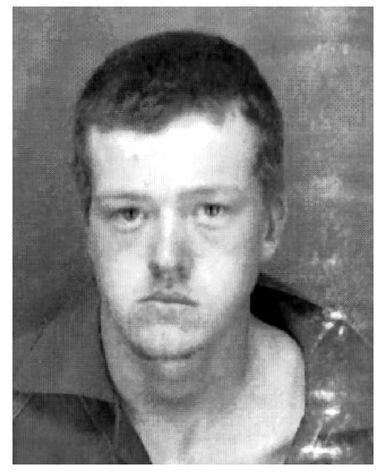
KEVIN FOSTER,“GOD”
LARRY KING, FORT MYERS SHERIFF’S DEPARTMENT
WERE THERE JUST THE SIX PEOPLE INVOLVED?
There really wasn’t any more than that. They were very much at their beginning stages. You had Kevin Foster, who was basically the ringleader, and he had access to weapons and things of that nature through his stepfather’s pawn shop. He was familiar with weapons and their use. A lot of weapons were recovered later. You can’t typify them as a gang; you couldn’t typify them as a “militia group” or anything like that. They had certain characteristics from those types of things which all combined into the Lords of Chaos. That’s why they called themselves that—they were intent on creating chaos for a period of time. When we captured them at the Hardee’s restaurant they were in the process of conducting an armed robbery in order to get funds to go to Disney World. Once they got there they were going to shoot African-Americans and things like that, supposedly after getting into character costumes. They were going to go out and wreak havoc in the park itself.
LEFT: PETER MAGNOTTI
RIGHT: DEREK SHIELDS
DID THEY CONFESS TO THIS?
It was information that was revealed out of evidence we gathered. At this point everyone either pleaded guilty or plea-bargained, with the exception of Foster. They’ve basically all agreed to testify against him. Magnotti and Shields were the last two to make plea agreements.
DID MORE PEOPLE OUTSIDE THE GROUP KNOW WHAT WAS GOING ON?
There were a couple of others on the fringe, that weren’t on the inside as far as knowing what was going on. There were dabblers that the group was looking at recruiting, so to speak. But it was very close-knit.
We did receive some tips from other juveniles, so they had been talking or bragging about it to some degree. Once we were aware of the situation, we were able to act on it. We basically diverted all our manpower into it. We had them under surveillance, and that was how we were able to make the arrests as they were on the way to pull off the robbery at Hardee’s.
HOW WOULD YOU DESCRIBE THEIR BACKGROUND?
Magnotti and Shields and the rest were bright students; in fact I’ve heard some typify them as more of the nerd type, because they were intelligent. Shields had a band scholarship.
THEY WEREN’T RUN-OF-THE-MILL DELINQUENTS?
Certainly not in that sense, but they did gravitate towards one person—Kevin Foster.
HOW WOULD YOU DESCRIBE HIM?
He’s certainly more of a cold and calculating individual, one that could be described as having a “dark side” to him. He’s got the attraction to weapons and how to make bombs—that’s what kind of took control. He was certainly cold and calculating in the murder of Schwebes; the witnesses have said it was something he didn’t bat an eye about.
DO YOU KNOW WHERE THEY GOT THEIR NAME FROM?
They had made a pact, so to speak, and written what their primary goals and objectives were, what they called a “declaration of war.” It was found in an envelope addressed to the county’s traffic violations bureau.
IS IT TRUE THEY CALLED FOSTER “GOD”?
PETER MAGNOTTI’S ARTWORK: “BRILLIANT”
—FORT MYERS NEWS-PRESS
It seems so. They were a close-knit group of individuals, as I mentioned—a second family so to speak. That’s what Foster was developing. He had a cult-like control over the other individuals. Part of it is intimidation. So it had that cult aspect. Whether this was just kids dabbling or they were really serious about that is still up in the air. I wouldn’t call Foster a particularly charismatic person, but to this group of individuals he apparently was. To the average person probably not.
ARE THERE ANY OTHER STORIES REGARDING THE CASE THAT WEREN’T IN THE INITIAL MEDIA REPORTS?
Not that I’m aware of, but we’re still limited in what we can say because there’s the pending trial of Foster.
WAS THERE ANY UNIQUE SYMBOLISM THEY WERE USING?
They had their logo and drawings and things that could have called more attention to them. There were a bunch of things that would lend to thinking of them as a little bit different.
AND THEY EXHIBITED A DEGREE OF RACISM?
I think it was pretty clear what their intent was when they went to Disney World. It might have more to do with the area and their upbringing might have had some impact on that. It’s more of a rural background.
The Lords of Chaos did not display any signs of overt Satanism, although they clearly held no respect for Christianity. They drafted a statement of purpose which is written in a similarly grandiose and antagonistic manner to many of the pronouncements from Varg Vikernes, Fenriz, and others in the Norwegian Black Metal scene. They share a similarly apocalyptic frame of mind, and they even use the same terminology as Vikernes when they glory in the idea of “laying waste” to the world. And like the Black Circle of Norway, they felt compelled to take credit for their actions and taunt the public with threats of worse atrocities to come. This is the text of their manifesto which was recovered by the police during the arrests:
DECLARATION OF WAR:
FORMAL INTRODUCTION TO THE LORDS OF CHAOS
This is not a confession. This is a claim to criminal acts committed against society by the militant, anarchist group LORDS OF CHAOS (L.O.C.). During the night of April 12, L.O.C. began its campaign against the world. A few juvenile acts of theft and vandalism began in the night, which in a span of a few hours escalated to massive proportions. [It all began] in downtown Fort Myers with the theft from and subsequent destruction of various county-owned vehicles (we shall not dwell on lesser acts such as broken windows, the torched cross...). After innumerable smaller acts of random violence, the L.O.C.’s night of terror took a turn in a new direction—ARSON. After gleefully torching The Hut, the L.O.C. successfully determined the response time of the fire department (which was all but disappointing). In contrast to media reports, the construction site, not the church, was destroyed next. The L.O.C. would like to convey the infinite amount of joy they received from watching the aforementioned inferno. Finally the L.O.C. descended upon the church. Using nothing but an ordinary cigarette lighter, your friendly neighborhood arsonists torched trailer and bus. Though very excited and giddy, the L.O.C. decided to call it a night, being very tired and dirty from a hard night’s work. In conclusion, the L.O.C. would like to deliver a message to officials and employees of the city—WE ARE NOT PLAYING ANYMORE! The activities of April 12 were random and spur of the moment, but the L.O.C. is scheming future “Terror Nights” and are planning greater endeavors. Lee County is dealing with a formidable foe, with high caliber intelligence, balls of titanium alloy, and a wicked destructive streak. Their ranks are growing, and they are developing a well organized militia. Anyone doubting the sheer power and connections of the L.O.C. should rest well that their day SHALL come and that the L.O.C. is a force to be reckoned with. Lee County has not felt pain the likes of what is to come. Be prepared for destruction of biblical proportions, for this is the coming of a NEW GOD, whose fiery hand shall lay waste to the populace.
THE GAMES HAVE JUST BEGUN, AND TERROR SHALL ENSUE...
Signed, the LORDS OF CHAOS
50The manifesto was not the only example of the kind of mindset operating behind the Lords of Chaos. After making arrests, authorities sifted through the members’ notebooks and computer files, only to find numerous stories and auto-biographical statements. Peter Magnotti wrote about himself, “I am a sociopath-paranoid-pyromaniac. Another quality of mine is that I can draw good and I can make friends easily.”
51 Indeed, he had recently been voted by his fellow senior class students as the best artist at Riverdale High School. An article from the local paper described Magnotti’s artwork: “His drawings, often brilliant and highly detailed, are in the comic book style, full of mind control, suicide, death, and diabolical plots. He loved explosives.”
52Both Magnotti and Kevin Foster wrote morbid stories of destruction for their own amusement. Foster’s tales feature him and his friends as central characters. They are full of typographical and grammatical mistakes, written in a terse, violent style. One story paints the Lords of Chaos as local heroes:
pete and kevin were vigilanties taking out bad guy’s ... cop’s were great full to them, wrong doers feared them and noone knew them. pete was known only as death. kevin was known as saint nic, because just like santa he knew if you were bad or good. if bad you DIE. the two man team made the streets safe to walk, made most of the populus white and took care of most of society problems [sic].
53
In one of Magnotti’s stories called “How I Killed the Earth,” his words sound like an eerie prophecy of the consequences of the later crimes they would commit. The protagonist in the tale laments: “I don’t know who I am anymore. I stumbled in a daze toward the light and found myself here. There’s blood on my hands and on my head.”
54Assessing the trail of mayhem left by the Lords of Chaos, Sheriff John McDougall said, “It was like a vortex of bloodlust and arson. It was consuming them. They couldn’t get enough.”
55 Identical observations would be fitting for the actions of the Norwegian and Swedish Black Circles. A Christian commentator, Tom Ascoll, writes of the Florida savagery: “Thank God that the Lords of Chaos stand out because they are exceptions and not the norm. But do not be deceived about why this is so. It is not because of poverty, lack of education, or any other social ill. Their actions are the consistent outworking of sin—rebellion against God.”
56LUKE WOODHAM
In a more recent and similarly bizarre chain of events, a group of highschoolers in Pearl, Mississipi banded together with a pact for sowing destruction in their small Bible Belt town. After killing his 50-year-old mother with repeated stab wounds early in the morning on October 1, 1997, Luke Woodham arrived at 7:55 A.M. to the Commons Room of the town high school and proceeded to open fire with a .30-30 rifle on the crowd of fellow students in the building, methodically executing two girls and wounding two others during the shooting spree. According to Joel Myrick, an assistant principal who later caught him, Woodham calmly walked down the hall “like he was out on a Sunday stroll.”
57 After tackling him outside after he left the building, Myrick demanded of the boy, “Why did you do that?” Woodham, who held a job as a delivery boy, replied, “I’m the one who gave you the discount on the pizza the other night.”
58 He later stated, “The world wronged me and I couldn’t take it any more.”
59 As it turned out, Woodham’s attack at Pearl High School was not his the first explosion of violence from the otherwise quiet and introverted student. A diary/manifesto was later found which detailed previous actions: “On Saturday of last week, I made my first kill. The victim was a loved one, my dear dog Sparkle. ... I will never forget the howl she made. It sounded almost human.”
60 Woodham and another accomplice sprayed solvent down the dog’s throat, stuffed it in a sack before dousing the bag with lighter fluid, lit it, and drowned the creature in a pond. Describing the sack sinking into the water, Woodham wrote, “It was true beauty.”
61Police later discovered that Woodham was part of a group of boys led by Grant Boyette, an 18-year-old the others referred to as “Father.” Allegedly he prayed to Satan and admired Hitler and the philosophy of Friedrich Nietzsche. The watchword of the group was: “We can’t move forward until all our enemies are gone.”62
Another boy involved in the group, Allen Shaw, claimed that in addition to talking about killing, Boyette and his followers worshipped demons and attempted to summon them to do their bidding. Supposedly the ultimate goals for the seven-member group of outcasts were money and power. Conspiratorial plans for mayhem had been concocted where they would cut the phone lines before utilizing homemade napalm to torch the high school. The boys would eventually escape to Cuba via Louisiana and Mexico after slaughtering their enemies.
In the aftermath of the killings and subsequent discovery of the group, the townspeople of Pearl desperately attempted to make sense of the carnage in their midst. With no clear rationale for the behavior of Boyette and his disciples, it was easy for the predominantly Christian community to arrive at supernatural explanations. As the father of a 15-year-old in the town told the Los Angeles Times, “It’s the grip of evil is what it is.”63
FINLAND
In Norway, the Black Metal crime wave reached a low ebb when the most active members landed in jail following the police crackdown. With the majority of the trend setters either dead or growing too old to play with matches, the blaze of church burnings flickered out, although sporadic attacks do still occur.
Nevertheless, the scene continues to grow internationally and the grotesque glamour of Black Metal finds new legions of adherents. Such is the case in Finland, which has had a small but thriving Black Metal scene of its own for many years. Finnish groups like Beherit and Impaled Nazarene have enjoyed considerable success worldwide, paving the way for many fans to form their own bands and follow in their footsteps. And just as in Norway, segments of the Black Metal subculture also wed themselves to an especially virulent strain of teenaged Satanism.
Ari Soronen, an officer connected with the Finnish Criminal Police, estimates that there are about 200 Satanists in Finland. It seems likely that the word “Black Metal fans” could be substituted for “Satanists” here, for even though Finland also has a small contingent of law-abiding black magicians (Finland’s most famous public Satanist actually holds a job as a customs official), the teenage Satanists comprise the majority. They wear the distinctive Black Metal make-up, which gives cause for some Finns to call them “penguins,” and they flock to music festivals where their favorite bands play. Most of them do nothing illegal, but that does not mean they shouldn’t be taken seriously. Soronen is especially concerned about the young girls in the scene. “I have spoken with girls as young as 12 that have been sexually abused,” he says.
BEHERIT
FINNISH HEADLINE: “HUNDREDS OF TEENAGERS ARE COMMITTED TO WORSHIPPING EVIL”
Merja Hermonen, a researcher with a clerical background, more or less agrees with Soronen’s assess-ment of the situation: “I have no reason to doubt that the stories about sexual abuse are true, but I don’t think things like that had anything to do with rituals as such. These kids are more into graveyard vandalism, and in a few cases some of them tried to dig up human bones. But there are just a few cases, and I think the scene is stabilizing at the moment.”
FINNISH HEADLINE: “DEVIL WORSHIPPERS ATE PART OF THEIR VICTIM: THE LEADER
OF THE GANG AND A 17-YEAR-OLD GIRL CHOPPED UP THE CORPSE ”
Sami Tenetz writes about Black Metal for the Finnish Heavy Metal magazine Suomi Finland Perkele. He also plays in the band Thy Serpent. Despite the fact that it isn’t a Black Metal band, Thy Serpent still attracts some of the corpsepainted crowd to its shows. “There aren’t many true Black Metalers around. Most of them only follow the trend because it has criminal associations. Their mental state is really bad, but that is usually because of problems at home, and not because of Black Metal or Satanism,” he says.
Unlike the scene in Norway, the crimes connected with Black Metal in Finland emanate from the fans, not the prominent artists. Despite its small size, this confused scene has produced one of the grisliest events to arise anywhere out of the Black Metal phenomenon. In one of the most notable cases in Finnish court history, four young Black Metalers murdered a friend in a scenario which featured overtones of Satanic sacrifice, cannibalism, and necrophilia.
At the time of this writing, the court case is not yet resolved, with some sentences (including a life sentence for the main defendant) being appealed. Therefore, those that could shed some light on the subject are politely but firmly refusing to give any comment. Reporting on the case is further complicated by the fact that the court has implemented a forty-year secrecy act on the entire legal proceedings. This means that many details will unavoidably remain sketchy. It is possible to piece some elements together, but the result is hardly a complete picture.
Hyvinkää is typical of the small towns that exist as satellites around larger cities, a commuter-friendly train ride away from the capital of Helsinki. Like other towns in the south of Finland, where the Swedish influence has been the strongest, it also has a Swedish name: Hyvinge. On November 24, 1998, a severely mutilated male human leg was found at a garbage dump in the town. Subsequent discoveries of other body parts in similarly inappropriate places made it possible to eventually identify the body of a young Black Metal enthusiast. After investigating the affair, the police finally arrested four of the victim’s closest friends, some of whom had even lived with him, who were charged with murder.
FINNISH HEADLINE: “JARNO ELG EVEN TORTURED HIS DOG TO DEATH”
A bizarre tale began to unfold in the Finnish media. On November 21, 1998, a gang of five black-clad youths visited a mobile Christian teahouse. Having become agitated after arguing with the Christians, they returned to the dreary apartment in Hyvinkää where a couple of them lived. Their apartment building is situated in a block that is perhaps the closest to a slum that the town has to offer, an area well known to the police as the source of many a domestic disturbance call. The locals sarcastically refer to this depressing section of Torikatu Street as “Luotikuja” (bullet alley). After arriving at the shabby apartment, the five youngsters listened to Black Metal records and drank heavily. The quintet were notorious imbibers of a drink called “Kilju,” a beverage brewed by adding yeast to orange juice and letting it ferment. Kilju smells bad and tastes worse, and, as can be imagined, this moonshine is only popular with those who demand nothing more than high octane from their liquor. To satisfy the thirst of the Black Metalers, there was usually a vat of Kilju going in the apartment.
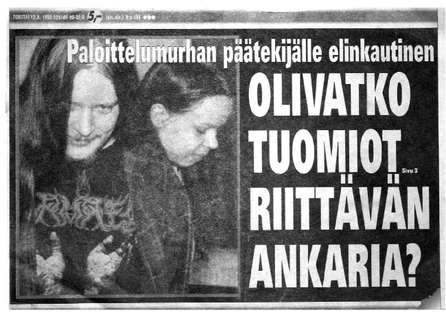
FINNISH HEADLINE: “LIFE SENTENCE FOR THE MAIN DEFENDANT IN THE DISMEMBERMENT HOMICIDE—WERE THE VERDICTS SEVERE ENOUGH?”
As the party got wilder, the details become hazy. The little information that is available to the public is contained in the application for a summons, a document penned by the District Attorney of Hyvinkää. It should be kept in mind that this is a statement from the prosecutor, and as such represents only one side of an ongoing court case.
For reasons that are unclear, the group turned against the fifth member, subjecting him to a series of punishments and humiliations. As the situation escalated, the apartment became the scene of what the application for a summons calls “...sadomasochistic acts requiring the subjugation of the victim, such as burning the victim with hot metal and leading him on all fours like a dog around the apartment.” The victim was also urinated upon. Alternately fainting and regaining consciousness, the victim was stabbed with scissors and “...his mouth was shut with a piece of duct tape, which the victim however was able to tear off. He begged the subjugators for mercy and promised them not to tell anybody about their acts. [...] As he went on moaning, his whole head, including the mouth and the nose, was taped.” (When visiting the building, we found that sound easily carries through the doors and walls of the apartments, so forcing the victim to keep quiet would be very important.) He was then stabbed to death.
After the victim died, the group “...started to carry out the rituals of Satanic worship known to them. They mutilated the corpse with scissors, dug out the inner organs, especially the heart out of the chest, cut off the genitals, as well as practiced cannibalism, necrophilia, and the disgracing of the victim’s sawn-off head by drilling the eyes, and other acts included in Satan worship.” (It should be mentioned that the District Attorney, Erkki Koivusilta, feels that the murder was not a ritual in itself, but was an emulation of things the gang had picked up in books and horror films.) After they finished their grisly business, the youths sawed the remains of the victim to pieces and then spread them to dustbins and garbage dumps around the area—where they were eventually found, leading to the arrest of the four killers. The man unanimously pointed to as the leader of the quartet was 23-year-old Jarno Elg, who apparently wielded considerable influence over his 17-year-old girlfriend and two male friends, respectively 20 and 16 years old.
The police have stated to the media that the murderers bragged about their acts to friends. The rumors supposedly spread like wildfire through the little scene, but were kept within it, partly due to fear of the killers but also because of a code of silence similar to the one found in biker gangs or the Omerta code of the Mafia. All the participants in the crime were deeply involved in Black Metal. This as also true for the victim, who had played in a Black Metal band called Utuk Xul. He had an unsavory reputation in the Black Metal scene, and yet was apparently admired by several others—some say simply because he was old enough to be looked up to by younger kids.
Finnish society reacted to the crime in a similar manner to how Norway did when first confronted with the criminal excesses of its own Black Metal scene more than five years earlier. Finnish newspapers screamed out headlines full of phrases like “Ritualistic Murder” and “Satan Told Me To Do It.” Jarno Elg was described by a journalist at the influential Hufvudstadsbladet newspaper as one of the two most hated men in Finland. This was probably not an exaggeration.
On the road that led Jarno Elg to the apartment in Hyvinkää, his life seems to have taken a serious detour. His career as a glue-sniffer and aspiring alcoholic led to psychiatric care at the young age of 11. He tried hashish the following year. By the time he was 16, young Jarno was drinking daily and devouring books on Satanism. This diet of Kilju, psychoactive chemicals, and teenaged Satanism was bound to go awry. In 1992, Elg and a friend decided to set fire to a medieval church in his neighborhood. The church was made of stone, so they set fire to the altar, the organ, and whatever else they could get to burn. When the fire department arrived, Elg did not try to escape, but instead cheered at the firemen.
Jarno Elg has been described as a bully type, but he seems to have been charismatic enough to gather a small circle of alienated youngsters around him. The clique were outsiders even to the Black Metal scene, and in the Hyvinkää apartment they cooked up their own version of Satanism, stirring various Wiccan and New Age flavors into the pot, and acting out rituals on a nearby hill. Money was made by shoplifting, and Elg seems to have had plenty of time to construct a world of his own and gradually slip into it.
In a side story that did little to help his image, it turned out that Jarno Elg had killed his dog in the same apartment on Halloween, twenty-one days before he turned on his friend. The killing of his unfortunate canine companion followed a similar pattern to that of the later murder: its head was taped before it was abused and stabbed with scissors. It is difficult not to see the killing as a rehearsal for bigger, badder things.
The researcher Merja Hermonen observed the actual court proceedings for a week. While she is careful to point out that she never talked to the perpetrators herself, and thus can only offer her personal opinions, she kindly agreed to relate some of her impressions of the murderers. “They were seeking something, like young people often do. I even had the feeling that they were changing their statements along the way. It seems like they are very lonely people. They are emotional outsiders, some of them in very profound ways,” Hermonen explains.
Since those who could shed some light on the motive for the murder are unable to talk due to the court’s gag order, Finland is rife with rumors. Speculations regarding the motive range from jealousy over Jarno’s girlfriend, to drug debt or just downright sadism. Some say that the killing might have been the result of a game that got out of hand as a blood-frenzy overtook the participants. All these theories are impossible to prove or disprove and, seeing as some of them even contradict each other, they should all be taken with liberal doses of skepticism.
In a surprise development in the case, Jarno Elg gave an interview to the Finnish magazine Hymy in its October 1999 issue. In the interview he tries to explain the murder more as a result of drunkenness than of Satanism. He also denies eating part of his victim’s remains, claiming that the cannibalism was something that his group bragged about to his friends. And while it is nearly impossible to discern a motive for this sort of murder, it is almost as difficult to understand why someone would go around bragging about eating part of his friend. Unless, perhaps, the parallels to the suicide of Dead can provide some clue. And if that theory is taken one step further, the case begins to look like a peculiar form of Norwegian cultural export.
A chain of reasoning might be as follows: Black Metal bands like Venom intended their Satanic image as a joke, but the music they created was imported to Norway and picked up by teenagers who were inclined to take this form of showbiz Satanism at face value. Then the Norwegian bands upped the ante by creating a reality out of Venom’s weird fantasy world—a reality which commanded international respect in a youth culture that venerates not only those who “talk the talk,” but those who “walk the walk” as well. Thus Norway in turn exported something that was one step even further toward the extreme. And if the Finnish killers are indeed the spiritual children of the Norwegian scene, they seem to have been intent, consciously or not, upon doing their Norwegian models one better—or worse.
If the description provided by the District Attorney is accurate, the murder itself appears so violent that it borders on a horror fantasy, almost as if it were the most puerile and excessive Black Metal lyric made flesh. This point was not lost on the media either, who claimed that the murder was directly inspired by a song by the band Ancient.
Even with her clerical background, Merja Hermonen warns against emphasizing the Black Metal connection too strongly when making observations about the defendants from the Hyvinkää case: “They have the same problems as all other young people. Problems that aren’t resolved continue to pile up until something goes wrong. To blame Satanism is scapegoating. If you focus on Satan, you don’t see the real reasons—and then you can’t do anything about them.”
Whether or not Mrs. Hermonen is right will perhaps become clear in the year 2038.
